
Among the Birds of the Mitten
It is late in the day. Whitetail deer are venturing out of the woods and into the field. They are at the far end, but my binoculars bring me close enough to identify which have antlers. This field is both ordinary and unique for the region. It is ordinary in its crop of soybeans, which, rotated year-to-year with corn, make up much of the output of fields in south-central Michigan. It is unique in that it sits in the middle of a park. The farmer had donated the uncultivated parts of his land toward the end of nature preservation, and so through the wooded margins of the farm wound walking trails, emanating from a small parking lot back at the road.
As the deer went about their evening meal, a strange, piercing wail rose from further back in the woods. It was not a person's voice, and it was a bit to shrill to be a coyote. I supposed it might be some sort of bird.
I left the field and the deer and walked the path back into the forest. The mix of oak and hickory at the front of the park gave way to a thicker stand of maple and beech. Away from the field, back amongst the trees, it was a good bit dimmer. Melanistic grey squirrels, endemic to the forests within a fair radius of Lansing, such as this one, darted about in the underbrush, semi-visible silhouettes too fluffy to be frightening. All the while, the wail grew clearer.
oooooooaah...
oooooooowaaaaa-gm-gm
ooooooooWAAAA-glm-glm
The path brought me through the woods and to a pond. There, it became a pontoon-borne bridge across one edge of the water. Cat-tail rushes at the opposite end swarmed with blackbirds. Cedar waxwings, identifiable at a glance by their bright yellow tail-tips, swoop back and forth over the water, catching insects. A family of wood ducks, the mother, brown with the species' signature mezzalunar head crest, followed by a dozen or so downy yellow-and-black young, edged out from the reeds. A great blue heron stalked along the unnaturally straight far shore of the pond, at the bottom of the causeway that had bifurcated what had been an even larger body of water to make way for a railroad track.
None of these birds were making the wailing call. I could hear it quite clearly now: a low coo going into a high scream, followed by two labored gulps, gathering air to repeat the phrase over again. I had a guess as to what it was; I retrieved my phone from my pocket and searched for audio of my guess's call. It generally matches. What's more, it worked. As I looked up from my phone, there, bobbing in what had just moments ago been an empty patch of water, was the wailing bird.
It was a uniform mid-value gray all over, except for black eyes and a black band around its beak. It was vaguely duck-like, though it was far smaller than a duck generally would be: about a third the size of a mallard. It was, as I had guessed, a pied-billed grebe.
Grebes are the smaller counterparts to loons and are only distantly related to the more familiar waterfowl ducks and geese. They are near-exclusively aquatic; their feet (which are lobed, rather than webbed) are set at the very back of their bodies, and so they can only walk, precariously, by rearing themselves upright, or else they can sort of belly-flop along, but they can't waddle overland with any real ability. They are also not fond of flying, though the Pied-Billed and many others can, if necessary to travel to a different body of water. But they are excellent swimmers, specifically underwater.
The grebe sat in the water, about 15-20 feet in front of me, for a minute or so, then it dove under. It surfaced some 50 feet away a few seconds later. It kept that up for a while: popping up, diving, popping up, diving. Sometimes, it dove how you might imagine, nose-first. Other times, it just sort of slouched, losing buoyancy and slipping under the water. Eventually, it returned to calling. I alternated between binoculars and camera.
I left the pond behind the farm as the sun was setting. The woods were darker yet, the squirrels having been replaced by a raccoon, which watched me leave from behind a fallen log. Thus concluded my favorite experience of birding.
The grebe calling | Video by Derek Edwards, July 2019
Birding, as an activity, is basically deliberate birdwatching. Birdwatching is the more common term among non-birders, but birding is preferred among many because observing birds, as in the case of the grebe, is as often a matter of listening as of watching. It's also a syllable shorter, so it's the term I tend to use.
That auditory component, hearing along with seeing, is a big part of why birding is a thing while, say, insecting isn't. One time I saw a big, red wasp, and I looked online to find out what species it was. And, while I found my answer (it was a red velvet ant, for the record, though those are wasps, not ants) I didn't see the kind of resources or online communities that exist to identify birds. Butterflies have their fans, but not the way birds do. From what I can tell, that's because butterflies don't sing. Birdsong is by and for birds, obviously enough. Birds sing to communicate with each other, not to charm human ears. And yet our ears are charmed all the same. Indeed, it has been argued that our ears hear birdsong better than any other sound in nature; typically, a songbird's voice hits a frequency between 2.k and 5 kHz, which puts them close to the peak resonant frequency of the human ear canal, so birdsong cuts through the noise of most natural settings, signaling the presence of life beyond our sight.
It is fitting that "birding" rhymes with "nerding", as the birder shares much of the knowledge/experience-hoarding tendencies of the comic collector, the trivia champ, and the video game 100% completionist. A bird guide may as well be a catalog to many people, filled with birds they either have or have not seen in the wild. Adding a new species to one's "Life List" is the driving goal in many birding excursions. Matters are not often left at "ah, look, a bird"; rather, each sighting brings questions of "what bird is it?", "how common is it in this area, at this time?", "have I seen one before, and can I get a better look now?", "have I photographed it before, and can I get a better shot now?"
The most acclaimed life list in American birding is that compiled by John James Audubon in the early 1800s. Audubon was a Frenchman who came to the US to check on his father's lead mine, but stayed after, reinventing himself as a daring frontiersman. His magnum opus was Birds of America, four volumes of his own accounts and illustrations of the birds he encountered in his travels through what is now the eastern half of the contiguous United States. His work in the study of birds earned him a place in the Royal Society of London; only Benjamin Franklin joined him an American member. Audubon lives on as the namesake of the preeminent birding society in America.

It is a crisp fall morning. I am in Lansing, though I am not in a city. I am in the parking lot of a small nature preserve at the eastern margin of the capital city's limits, located next to the cemetery where automaker Ransom Eli Olds now makes his rest on the top of a little hill. I am not alone. I have, this morning, infiltrated a group of members of the Michigan Audubon Society.
Well, perhaps "infiltrated" us a bit much. More precisely what's happened is that, a few days ago, the Michigan Audubon Society held an open meeting (not concerning birds, actually, but butterflies), at the end of which it was announced that there would be a nature walk scheduled that weekend at the nearby Fenner Nature Center. It was mid-Fall, the time of the southerly migration, and many birds normally found well north of Lansing would be in town as they made their way to Tennessee, or the Gulf Coast, or even Venezuela, in a few cases. Fall is harvest time, for the farmer and for the life-lister.
The Michigan Audubon Society has furnished a guide, whom I will call Bob the Bird Man. He's a lanky fellow with a beard and a ball cap, who looks a bit like John Muir having been given the "what would they look like in modern times?" treatment you see done online every once in a while, to George Washington or Caesar. His first question to the group is "Are any of you visiting from the West Coast?" If any of us are, he intends to make sure we see a cardinal this morning.
Cardinals, for any readers unfamiliar, are a common species of grosbeak, named for the male's bright red color. While people in the Eastern U. S. see them often, they don't live west of the Rocky Mountains. They are the second reddest bird in Michigan, and are much more commonly seen than the Scarlet Tanager, the reddest bird not just in Michigan but probably the world and the reddest thing, bird or non, that I've ever seen. Something to keep in mind about birding is that it's quite regional, and what might be a common sighting for a local might be a rare treat for a visitor.
All of us live in Michigan, including one gentleman with a British accent, so Bob the Bird Man takes us looking for other things. We walk through a line of trees at the edge of a meadow. Black-capped Chickadees and American Goldfinches are the most common sight, though our collective keen eye picks out a Red-Headed Woodpecker, an American Redstart, and a Warbling Vireo from among the foliage.
Now, something about me that you should know is that my favorite birds are generally water birds, not songbirds. I'm not sure, but I think this might be a bit gauche. Going back to that butterfly meeting, the lady in charge had asked the room if they'd seen any good birds lately. I mentioned seeing a Hooded Merganser, I think it was, and the reaction was kind of muted. There weren't any follow-up questions; it wasn't something the people found very interesting.
One birder consults me about what a largish bird perched silhouetted against the sky might be. From its size and the shape of its beak, I believe it to be a Northern Flicker. There is a recurring motif in the story of my life wherein people ask me to identify a Northern Flicker.
"I saw a big woodpecker come to my suet feeder. It was light brown and it had a red spot on the back of its head. What might that have been?"
"I saw a bird pecking at the ground like a chicken, but it wasn't a chicken. It was a normal bird with spots. What does that sound like?"
"I was out in the country and I saw a bird fly by with yellow wings. What bird has yellow wings?"
It's gotten to the point that if someone points out a strange bird to me, I presume it's a Northern Flicker until I see otherwise.
The members of the Michigan Audubon Society were not duck people, they are warbler people. That's what we're all here at Fenner to see. New World Warblers, or wood-warblers as they're sometimes called, are tiny little passerine birds that live in forests and are the top-tier birding targets. ("Passerine" is probably a word I should define. Literally, it means "sparrow-like" in Latin, but what it means in English is a normal bird-type bird. Not an ostrich, not a penguin, not a seagull, not a falcon, not a duck, just a normal little bird that flies and perches on things.) Warblers are hard to watch because they are small, they are quick, and they are shy. There are hundreds of species in the world, about fifty of which can be found in the United States. Unlike the members of other large families, such as the sparrows, the wood-warblers all look fairly distinct. The trick is getting a good look at them.
Bob the Bird Man knows his warblers. He had a bird guide, the Eastern Region volume of Sibley's if I remember correctly, and he referenced it occasionally. But he also was able to recognize the chirping, not the song, mind you, just the chirping, of a female cerulean warbler that was hiding down in the underbrush near a stream. He was the one to initially spot most of the warblers, which would bring the members of the Michigan Audubon society crowding around him to get a glance at a yellow blur through their binoculars. We were all keeping quiet, but a few dozen giddy people keeping quiet is still about as loud as a single person who's not keeping quiet, so we generally only saw warblers darting away.
I'm not a warbler person.
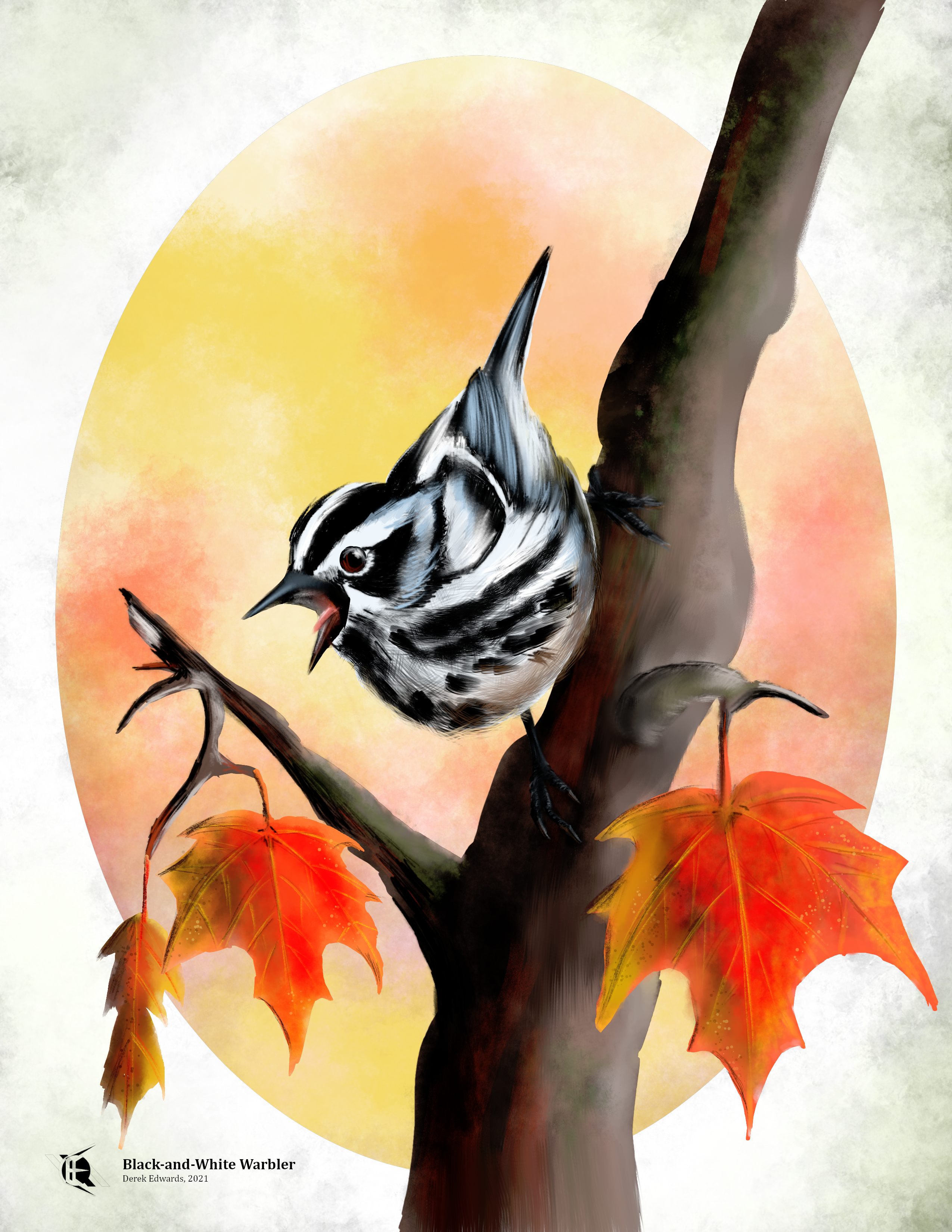
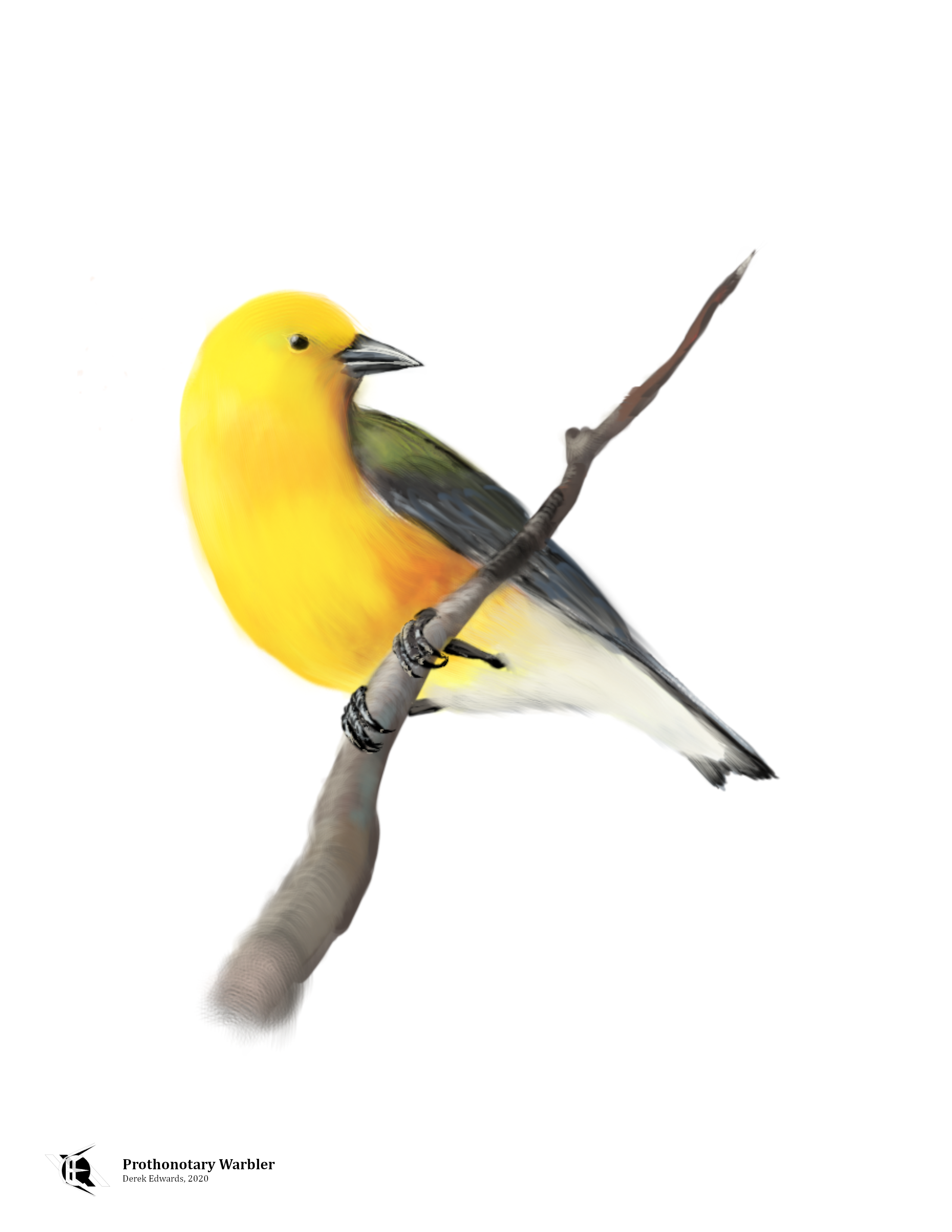
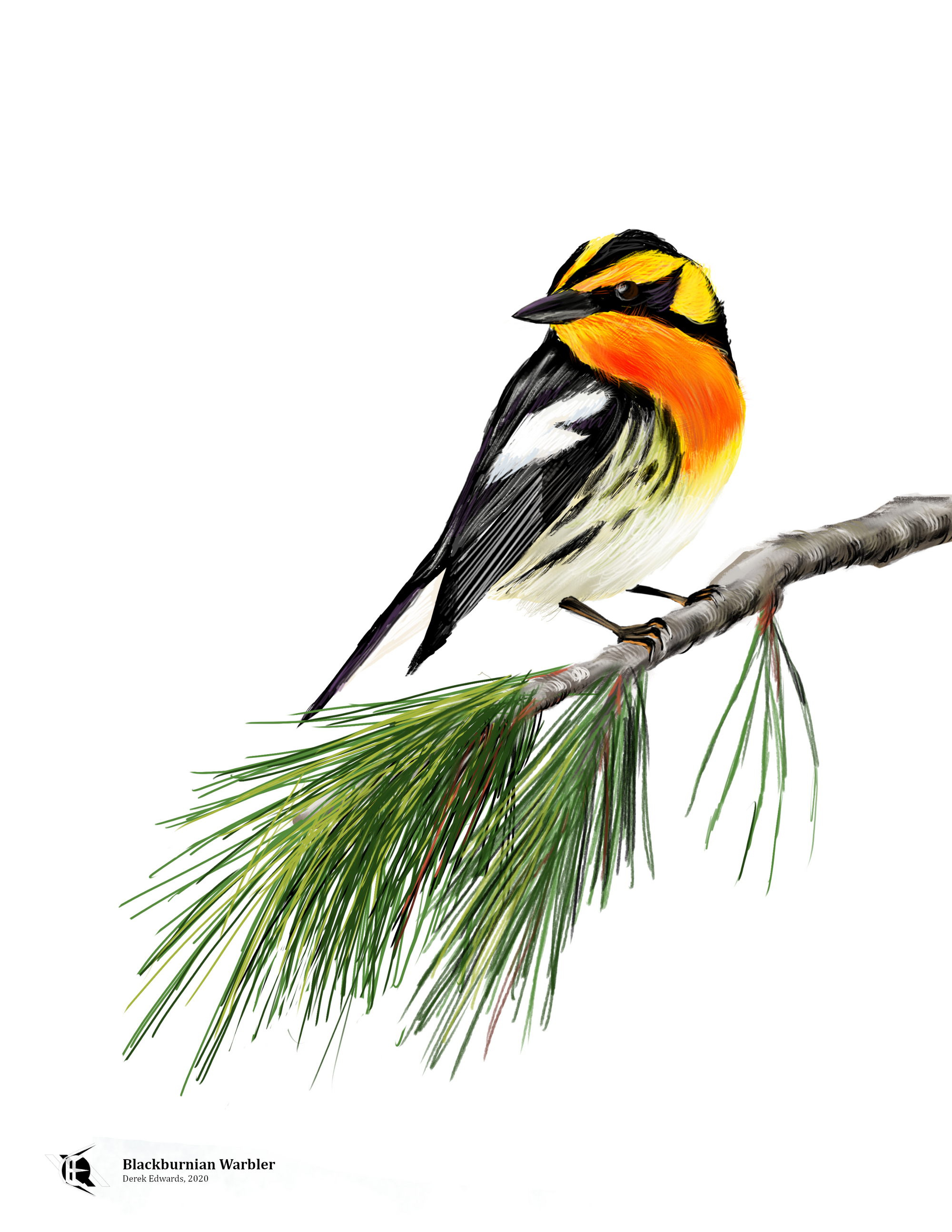
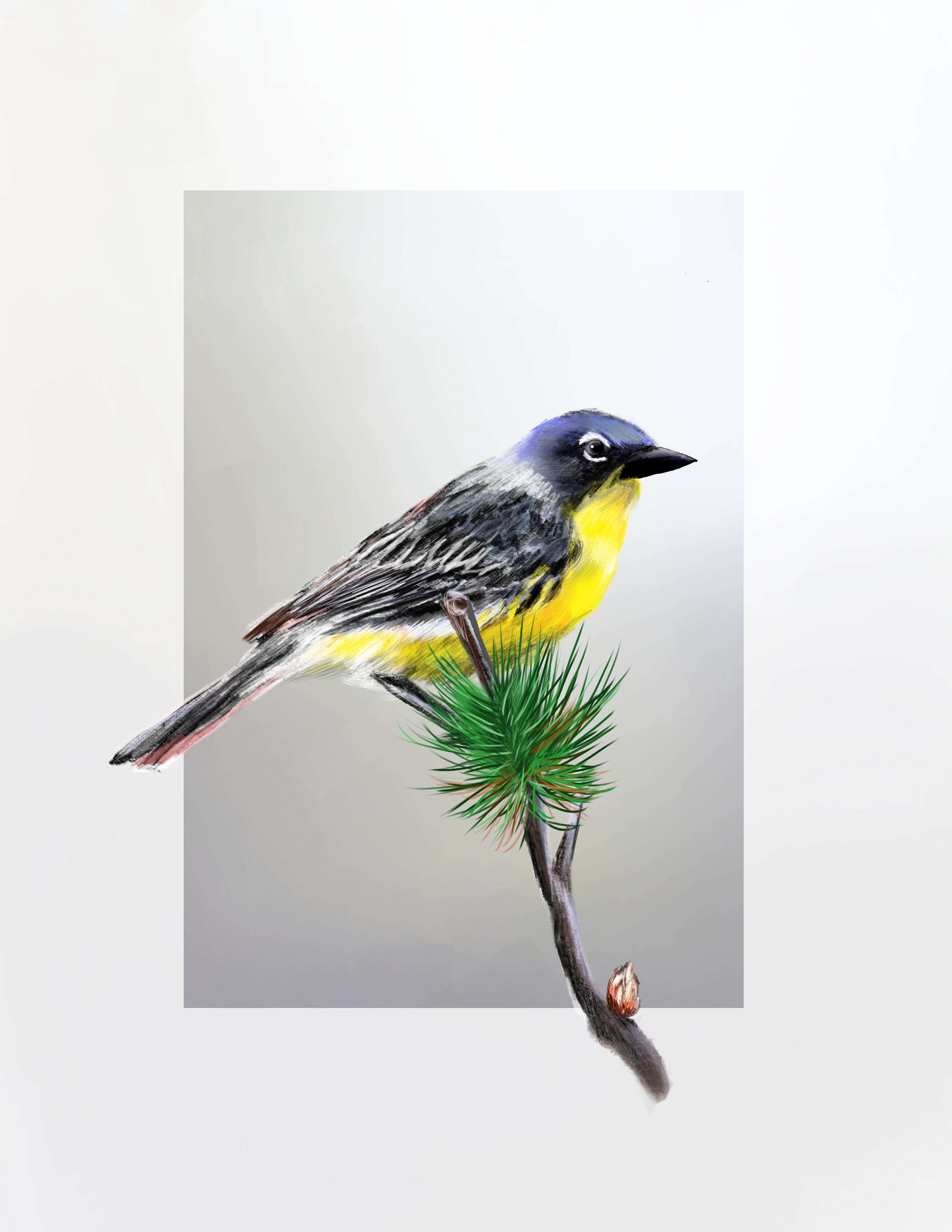
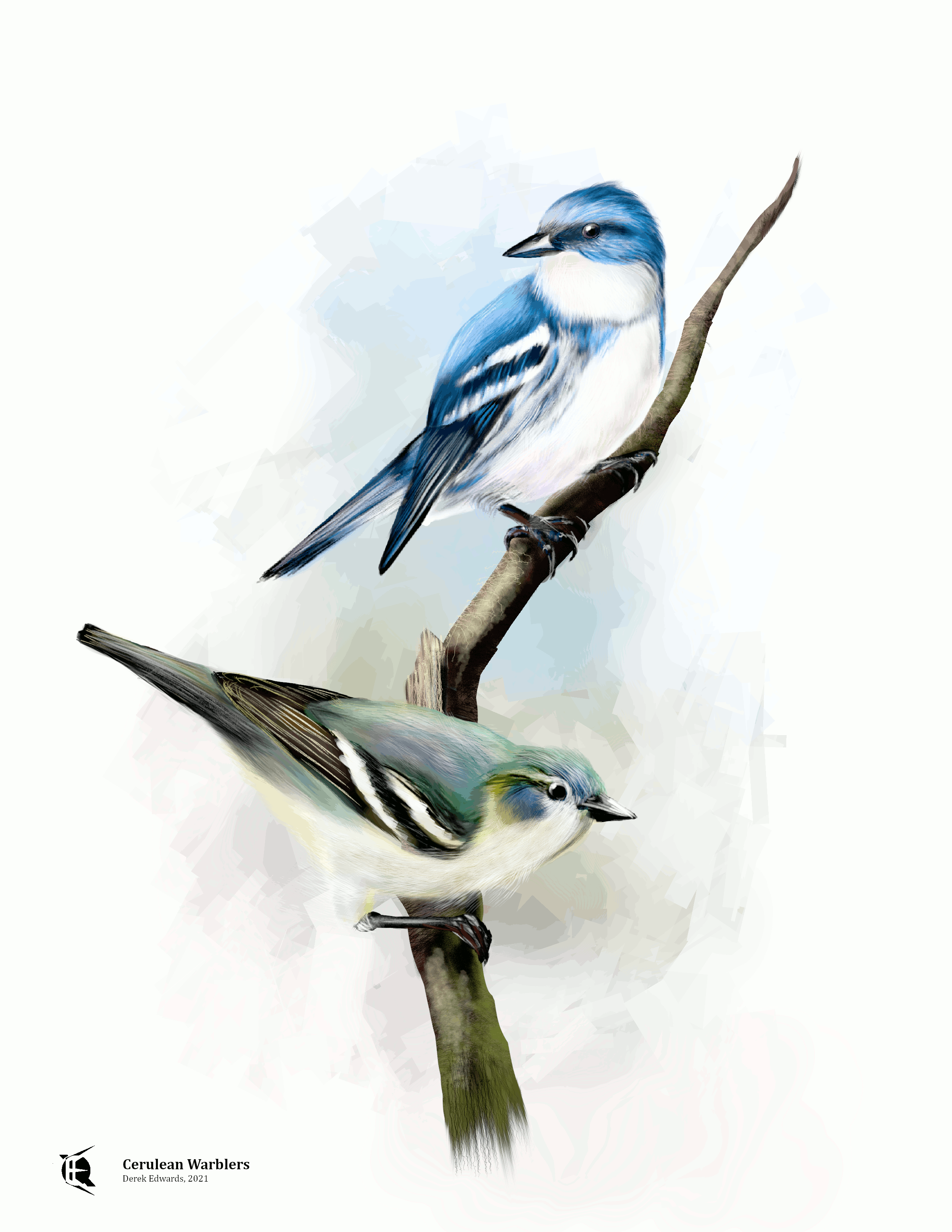
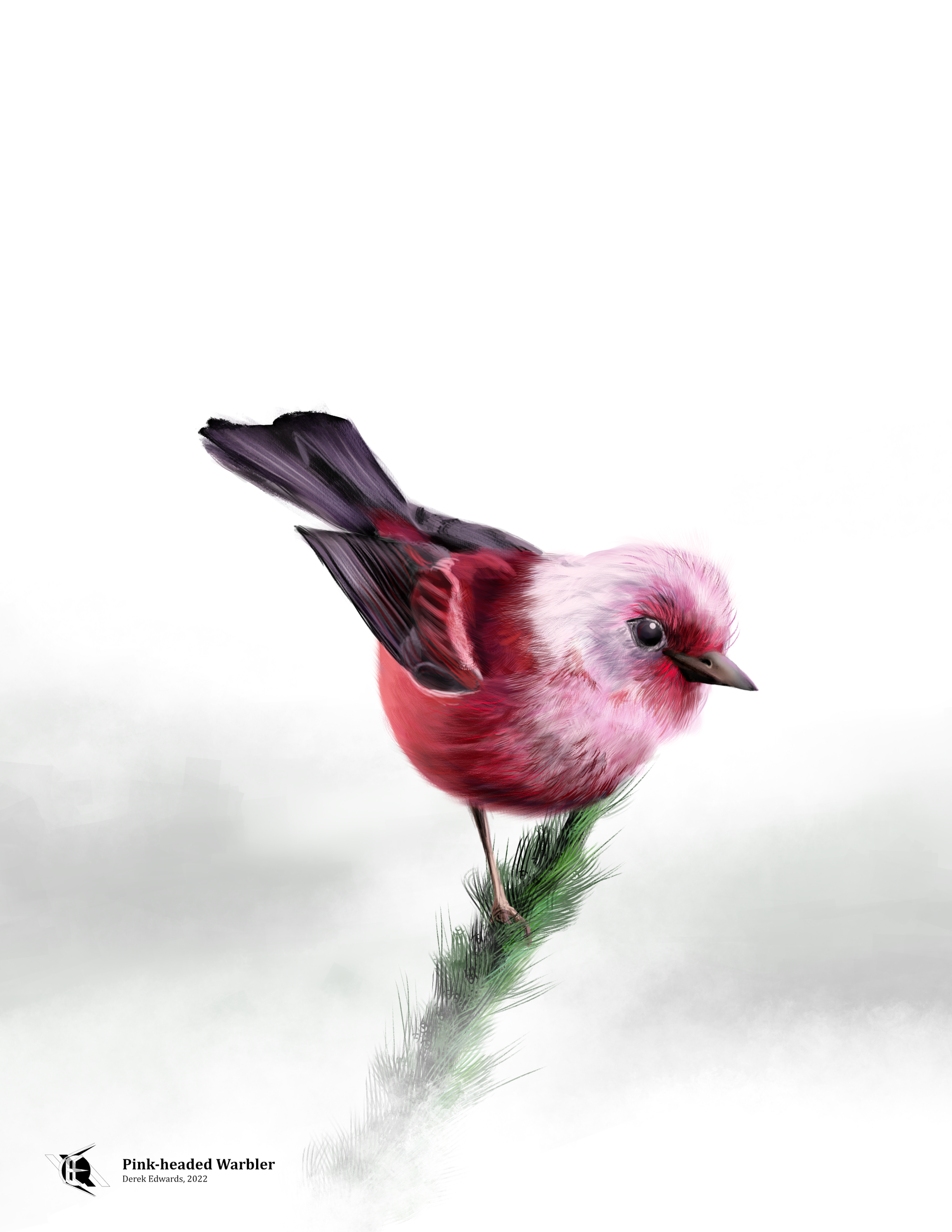
Several kinds of New World warbler | Artwork by Derek Edwards
Lower Michigan is, with only a few exceptions, a swamp. That's not to say it's all mud, but there are few really dry regions, and lots of ponds and lakes. In the Spring, especially, standing water is the rule.
The general marshiness of the Mitten was seen as a curse back in the day. An 1815 report by Ohio Surveyor General Edward Tiffin described Michigan territory thusly:
"It is with the utmost difficulty that a place can be found over which horses can be conveyed...it is so bad there would not be more than one acre out of one hundred, if there would be more than one acre out of one thousand, that would, in any case, admit of cultivation."
The Tiffin Report was a bit exaggerated, having been based on surveys of the land surrounding Detroit and Saginaw. Both of those regions are floodplains, with no areas of elevation to speak of at all. Even by Michigan standards, there's no consistently dry land around there. Tiffin's surveyors apparently had gotten tired of measuring in the mud and had called the region a loss prematurely. Tiffin convinced the U. S. Congress to cancel plans to distribute land in Michigan to veterans of the War of 1812, instead distributing land in Missouri (which, conveniently for Tiffin, meant that settlers would have to pass overland through Ohio.) Settlers avoided Michigan for many years, which put the U.S. Government in an awkward position, considering that they had just fought a war against the Indians there to seize the territory for settlement. Land prices fell to incredible lows. Eventually, some enterprising folks took notice that on the Great Plains, where many people were living in sod huts for want of wood to build with, the timber of a single pine tree was selling for the price of an acre of richly-forested Michigan. The resultant timber boom cleared all the old-growth forest in Michigan, as well as Wisconsin, but it got Americans into the interior of the Mitten, where they saw that the land could actually admit of a lot of cultivation, given that you prepared fields with sufficient drainage first. Michigan is a major agricultural producer today. (We've also planted back a lot of the trees.)
Wetlands were disdained for much of human history, since they aren't good places to farm, or to do much else we humans do, really. But in modern times, when we've actually gotten good at doing something about all those swamps, we've noticed that, without them, the parts of nature we do like, such as birds, don't seem to do so well.

It is dusk, it is mid-October, and I am sitting huddled under a blanket out on a hillside with a few hundred other people. Before us lies 200 acres of marsh. Atop a snag toward the front sits a juvenile bald eagle, brown all over. At the back, so far away and so numerous they look like a swarm of insects, is a flock of blue-winged teals, which were identified by a gentleman with a high-power spotting scope. Blackbirds are filling the reeds, their buzzing calls providing the white noise for the evening. But we aren't all out in the chill wind to see any of these birds, they're all bonus. We're out to see a specific species, which is gathering in the marsh before us by the thousands after a busy day foraging in the surrounding fields. This, this great mutual gathering of Antigone canadensis and Homo sapiens alike, is CraneFest.
The Sandhill Crane & Art Festival is put on as a joint effort between the Michigan Audubon Society and the Battle Creek Kiwanis. It was canceled this past year due to the imprudence of holding even an outdoor event of that size in the middle of a pandemic, but it has otherwise been an annual event since 1994. I don't think that it's the largest gathering of Michigan's birders; the Tawas Point Birding Festival, or maybe the Spring Fling at the Whitefish Point Bird Observatory, up past the Soo, would take that title. I know it's not the largest gathering of sandhill cranes; that occurs in the Platte River, near the eponymous Sand Hills of Nebraska. But CraneFest nonetheless is a highlight of many calendars. It features a day of activities and features dozens of vendors, ending with the viewing of countless cranes coming in to roost.
Like the warblers of Fenner, these cranes are migrating south. Luis A. Mendez and any other readers from Florida are probably mystified that people would pay money and sit out in the cold just to see sandhill cranes, since, by the time they've reached their wintering grounds, they make themselves a bit of a nuisance, standing in the road, etc. Some cranes do spend the summer in Lower Michigan, paired up together; if you see three, then one is the offspring of the other two. But they only flock by the thousands during migration, and thousands of anything is worth seeing, given the chance.
Sandhill cranes are the second tallest birds in North America, standing a bit less than 4 feet tall when they pull themselves upright. They are grey in plumage, though they often paint themselves a rusty brown with mud to better hide from predators. On their forehead is a heart-shaped bald patch of red skin. As cranes, they are distinguished from the similar-looking storks, herons, and egrets by their trumpet-like vocalizations, their more varied diet, and their practice of keeping their necks outstretched in flight.
CraneFest may be "CraneFest" but the cranes don't arrive in any great number until the evening, so the day must be filled with other activities. There are live animals being shown by handlers from the Binder Park Zoo and the Michigan Hawking Club, the latter of which has brought a Eurasian Eagle Owl. There is a children's activity tent, with some sort of arts-and-crafts going on inside. There is a food truck selling "Cosmic Burritos" parked by a pavilion. There are many tents set up, for the vendors and organizations that sponsor CraneFest. There are artists and artisans, selling carvings, paintings, and photos of birds. One fellow is selling hand-lathed custom pens, made from acrylic in colors evoking birds. Another tent is filled with polished rocks and fossils for sale, including Petosky stones, a favorite among Michigan tourists. A local sugarbush is selling maple syrup. More than one tent is selling optical equipment: cameras, tripods, spotting scopes, special high-light-intake polarized binoculars, designed to alleviate the drawbacks of tunnel vision and help you better spot a warbler. Various relevant interest groups have information and sign-up booths: the Audubon Society, Ducks Unlimited, the Sierra Club, the Citizen's Climate Lobby. The Kalamazoo Astronomical Society is also present as if to say "I heard you liked looking through eyepieces at things." And, inevitably, someone is selling handcrafted soaps, giving the place the aroma I'd imagine an attic in Provence would have.
There are also guided nature walks. I go on one led by a botanist. If he felt out of place at a birding festival, he didn't let on, pointing out wild grapevines (Concord or Niagra, very different from the usual grapes found in stores, which are European) and shagbark hickories (well-named and strange-looking) and some sort of grass (that wasn't actually a true grass) as if that's what we'd all come here to see today. It was interesting, though we were keeping our eyes open for birds as well. An overlook gave us a nice view of a flock of wood ducks, green-crested and scarlet-billed for their breeding season. Once we reach the earthen dam where the water level of the marsh is regulated (just too deep for coyotes to reach the sleeping cranes at night) I spot a pied-billed grebe tooling around a small lagoon. The botanist is quick to point out a sassafras tree, its leaves banana-yellow in this autumn season. As we end our tour of these woods, the botanist spots a patch of melon-sized puffball mushrooms, which he tells us a quite tasty if prepared well. Mushrooms seem to be to botanists what butterflies are to birders: not quite the correct thing, but close enough to attract interest.
When the cranes finally began to arrive they mostly hid behind a hill. I left a bit earlier than some of the others; I was cold, and my crowd had spooked the crane's crowd, and it was getting too dark to see much anyway. But, if they are able to hold CraneFest again this year, I hope to go back.

Ornithology is the field of biology concerning birds. Some sort of study of birds has been going on more or less forever; Aristotle wrote one of the earliest known ornithological lists as part of a general survey of animals, and the domestication of poultry involved early ornithological principles long before that. But as European nations began to build far-flung empires, the modern practice of geographic ornithology, the study of birds' distributions and migrations, grew to prominence. This coincided with the work of Carolus Linnaeus, who developed the method of taxonomy (the division of living creatures into increasingly specific categories) and the use of binomial nomenclature to produce one name to be used by scientists of every language. From there, it was only a short step to go from ornithological catalogs to the first bird guides.

There are a lot of bird guides out there, for all different regions of the world. If you're shopping for a bird guide, keep in mind that the point of a bird guide is to help you identify what you just saw/heard. Don't get some huge encyclopedia with a page of text about each bird. The one I use is illustrated with paintings rather than photographs. I like this, since photos can sometimes get visually very busy, and the paintings actually make the important markings a bit clearer. It also depicts the entire bird's entry on one page, which some guides actually don't do, leaving you going from one page for a picture of a male, another for a female, another for a map of its range, etc. Avoid those.
For a long time, amateur birders got more from the research of professional ornithologists than they tended to give back in gathered data, but the internet age has allowed for much easier surveying of bird observations. Cornell University, located in the bird-rich Finger Lakes region of upstate New York, is the premier school for ornithology in the United States. The Cornell Lab of Ornithology maintains many resources for birders. The Linda and William Macaulay Library is a collection of photos, audio, and video recordings of birds from around the world, all digitized and made available online. There's Merlin, a smartphone app that works as both a standard field guide and a new sort of bird identification tool, using a 5-point questionnaire to make a guess about what bird you've seen. But the big thing Cornell has done, the thing that's left a real lasting mark on birding, is eBird.


eBird.org is to geographic ornithology what sites like Waze and Google Maps are to practical navigation. Birders around the world use eBird to report sightings, and the Cornell Lab then compiles that data into a map of birds. From an ornithological perspective, this data is useful for defining ranges, tracking migrations, and estimating populations. For birders, the live map of bird sightings provides an atlas for their future excursions and a journal of excursions past.
There have been some criticisms of eBird. As scientific data, many sightings are not verified, though unusual reports are reviewed, and are really only useful in aggregate. Sightings are clustered around human population centers rather than avian ones; more birds are seen in metro Chicago than anywhere else in the Great Lakes region, but that doesn't mean most of the region's birds actually live there. Birding culture has been gamified, a bit, by things like eBird's public leaderboards. (At time of writing, the top eBirder in the world is retired diplomat Peter Kaestner, who has observed 9,284 different species on 8,329 excursions.) And eBird really leans into life-list completionism and something the British call "twitching", the practice of chasing after specific birds reported by other birders. (I'm not immune to this, by the way. I found one of my favorite duck ponds when I was twitching after a Northern Pintail duck. I didn't see it, but I did see several other non-mallards all in one place.)
Still, eBird is generally considered a useful tool for the modern birder. I use it not as much to seek out specific birds as to find good birding spots. For me, that means visible, accessible wetlands full of waterfowl. In all of Lower Michigan, one place matches my criteria more than any other.

It is just becoming the golden hour, and I am driving through the sugar beet fields to the south of Saginaw. It has taken me too long, in my estimation, to get there. If you want to travel from Mid-Michigan to the Bay Region by freeway, the way you'd typically cover such a distance, you need either to go east to Flint, then north-northwest, or else go all the way north to Clare, then come back southeast through Midland. There's no straight road from Lansing, Jackson, or Grand Rapids to one of Michigan's oldest cities, bizarrely. So, you drive through stretches of some of the state's flattest land on country roads. Watch for barns in the next county over as you go.
I'm up here to visit the fifth-best Michigan birding spot on eBird. I'm not going to the best Michigan birding spot, Whitefish Point, since that's all the way up in the U.P. And I'm not going to the second-, third-, or fourth-best Michigan birding spot because those all made the list because they're popular weekending spots for Detroiters; they're full of people moreso than birds. The fifth-best, though, is not a park. It is a wildlife refuge, specifically one set aside as a stopover for migrating waterfowl. I know I'm getting close when I spot herons flying in and out of the ditches beside the road.
The Shiawassee National Wildlife Refuge is a 10,000-acre wetland set at the confluence of several rivers: the Flint River, which has been in the news for its connection to a public works disaster that's still in the courts; the Tittabawassee River, which was in the news for a dam collapse that flooded the city of Midland; the Cass River, whose namesake, Lewis Cass, the governor of Michigan Territory leading up to statehood, was briefly in the news when his name was stripped from a government building over his support of slavery and Indian removal; the Bad River, which is generally of one spirit with the news, which is often also bad; and the Shiawassee River, which gives the refuge its name. All these mix together to form the Saginaw River, which drains the wetland into Saginaw Bay. Being as large as it is, the Shiawassee NWR is a bit much to explore on foot. It has several pedestrian trails, but its most popular attraction, the one I'm headed to, is the six-and-a-half mile one-way loop of gravel road that winds through the middle of the refuge. Birds aren't actually that disturbed by cars, apparently, so, so long as you stay in your vehicle between the lookout stops along the drive, you'll be fine and the birds will be fine.
I'd actually meant to visit the Shiawassee NWR a few weeks before I did, but one of the great moments in Michigan twitching history had happened when a wood stork, a Gulf-coast-and-Latin-American bird which had only been seen in the state once before, in 1963, arrived in a pond right next to the loop. The Wildlife Drive became clogged with cars. A total of 227 photographs of this particular stork were uploaded to eBird. I might have gone to see the Shiawassee Stork myself if it weren't for the fact that 1) I didn't want to sit in a traffic jam to see one bird while the other birds were made skittish by all the people, and 2) it was August of 2020, during the COVID-19 pandemic, when birding had become the thing I could do outside the house while keeping safely clear of other people. So when that stork arrived, I went elsewhere. Specifically, I went to an Audubon preserve the Western Interlobate, which was down a dirt road, past Amish country, near a small body of water literally called "Podunk Lake". I had that place to myself.

Anyway, the stork and the stork-seers had all left, and as I arrived at the head of the Wildlife Drive, there was no one to greet me besides at great egret who was—and I can think of no other way to describe this—posing for a portrait atop a stump by the entrance. That egret set the tone for the evening, which was an excellent bit of birding. I've been to zoos where animals felt less on display than here. I would see seventy-five more great egrets that night, along with three pairs of Sandhill Cranes (they don't form the big flocks until later) thirty or so Great Blue Herons, more ducks and geese than I could count, a swarm of double-crested cormorants that had roosted in a patch of snags just off in the water from one of the turn-offs. I saw ten times the number of pied-billed grebes that I had seen, to that point, in my entire life. I saw coots and moorhens, gulls and terns, two dozen pelicans, and four pairs of trumpeter swans.
There were non-aquatic birds living in the marsh as well. An osprey and two bald eagles were there for the fish. Tree and barn swallows were there for the insects. A wood thrush, a polka-dotted cousin of the American robin, made an appearance high in a tree. I saw an indigo bunting: think a sparrow, but with feathers the blue of a Windows 95 crash.
I added quite a few species to my life list at the Shiawassee NWR, but even if I had seen every sort of bird I saw that night before, the experience would still be one of my best memories. Moreso than in anywhere else I've been birding, Shiawassee felt like the birds' place, like it's where they keep the waterfowl. There was no street noise, no farm fields, no railroads, no festivals, just the road through a swamp that stretched in all directions as far as could be seen, teeming with swimming, flying, perching, diving, quacking, cackling, chirping, crowing life.
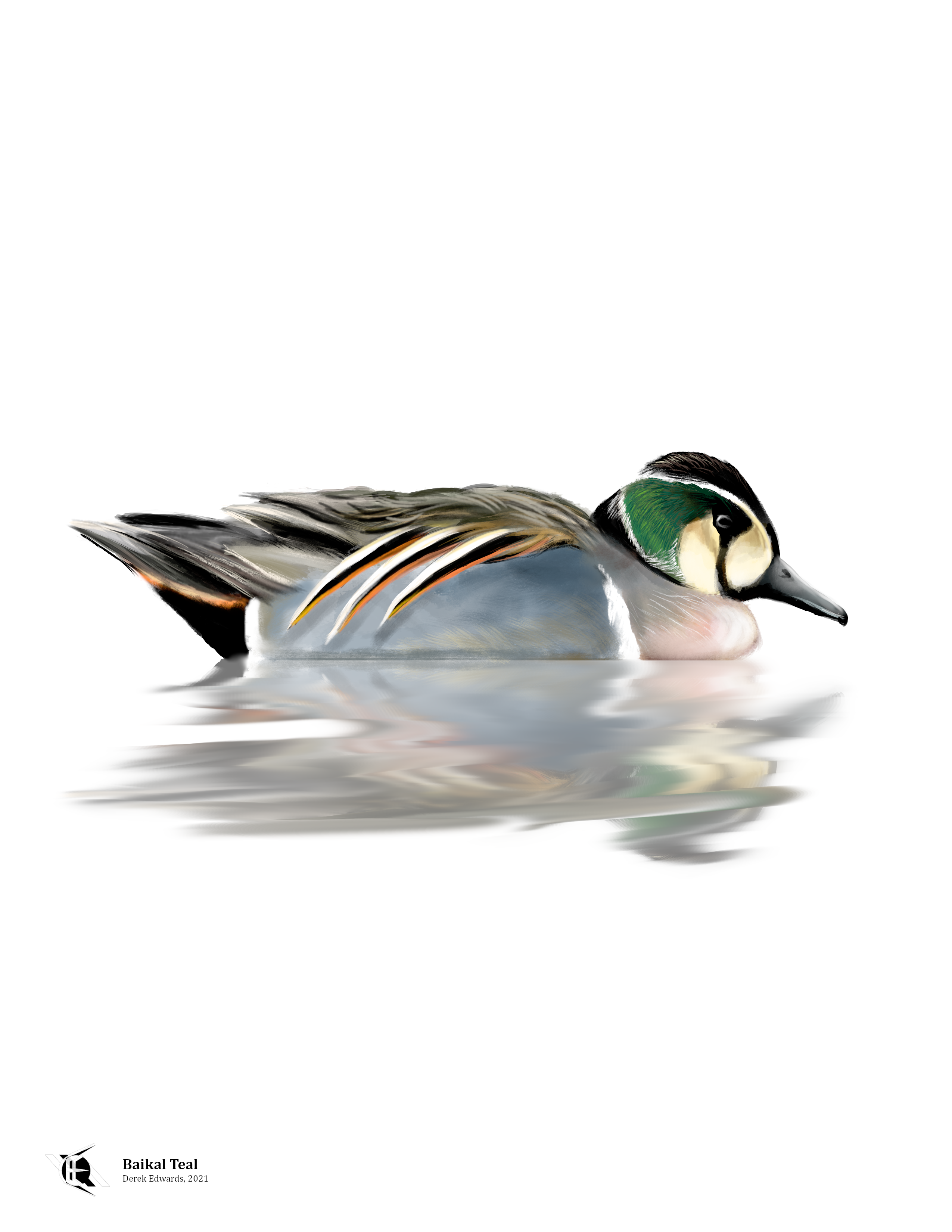
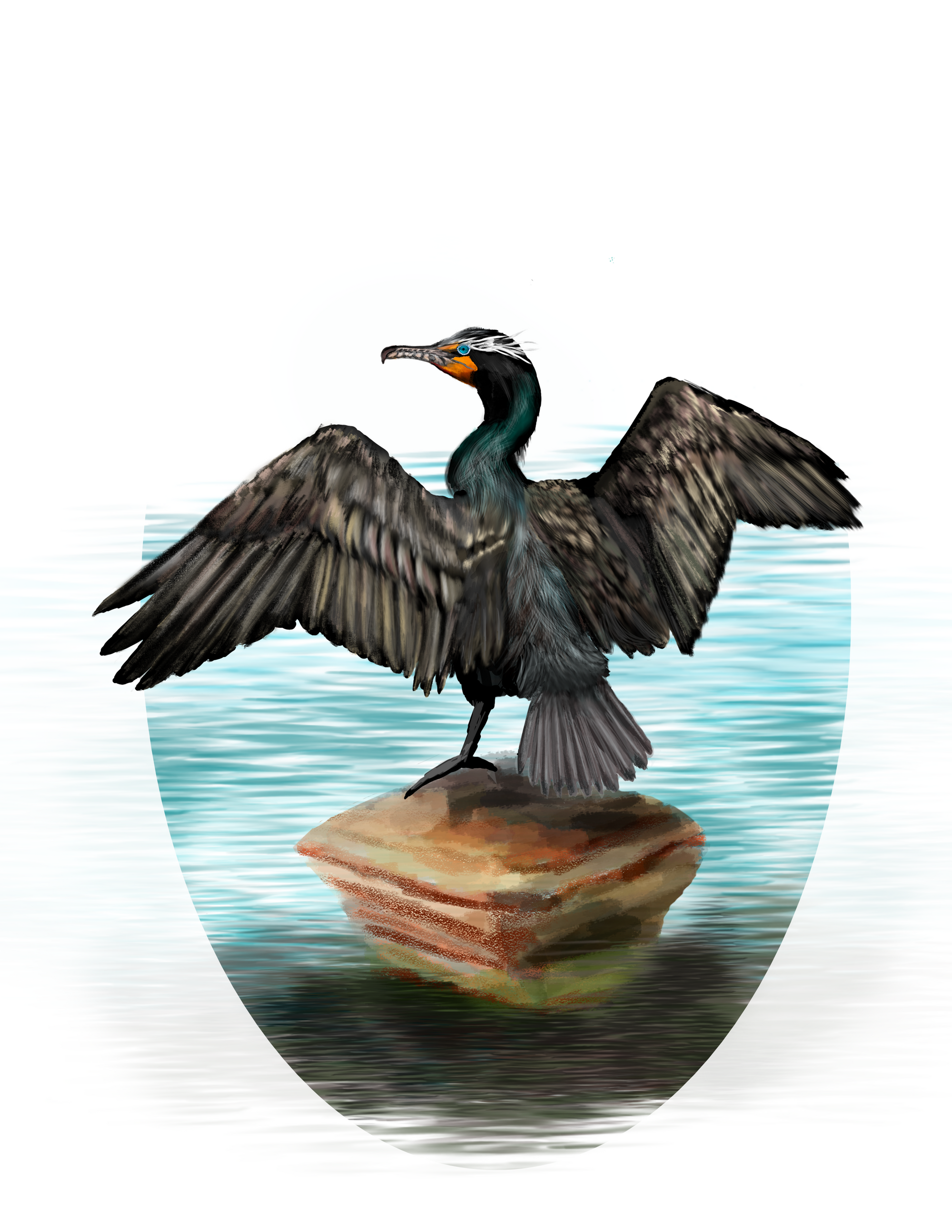
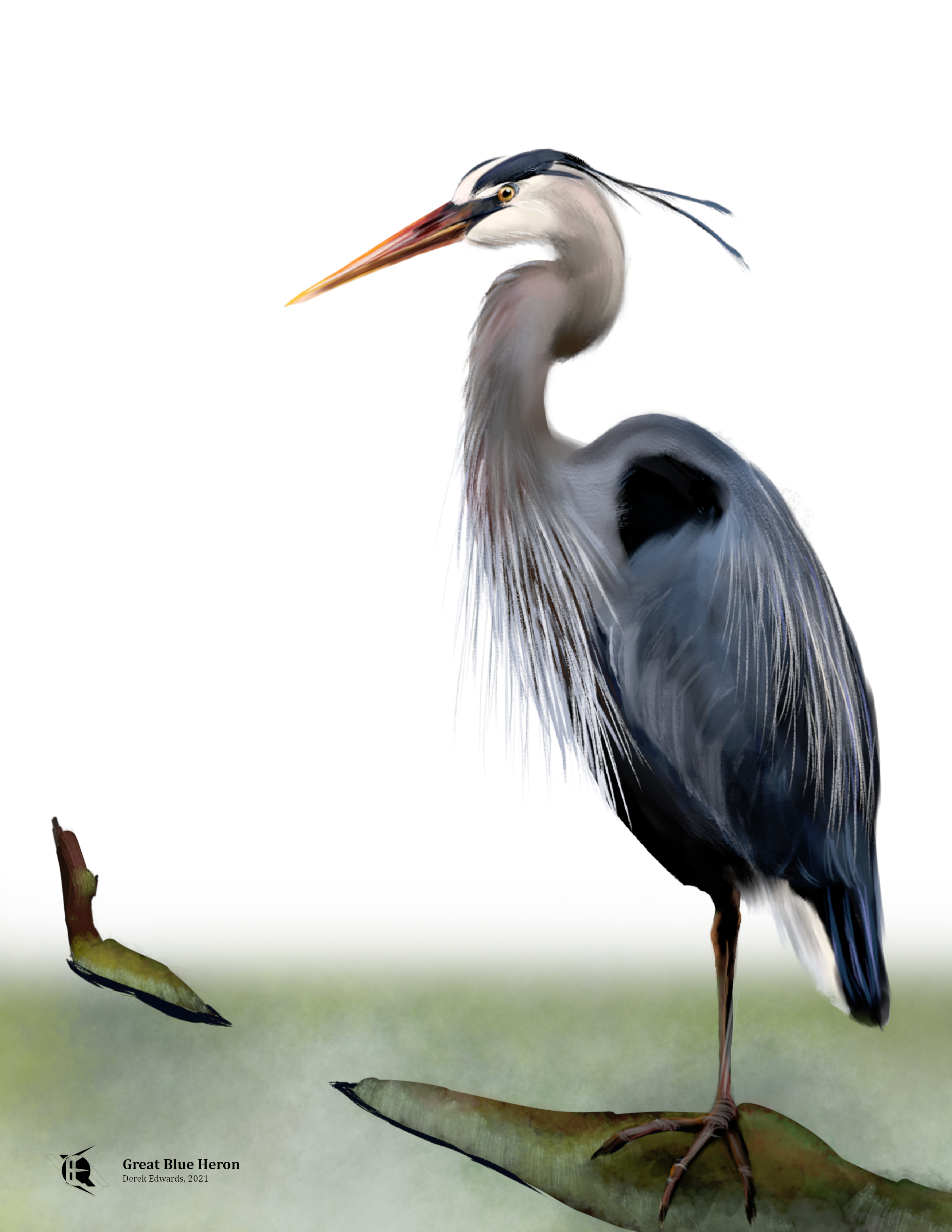
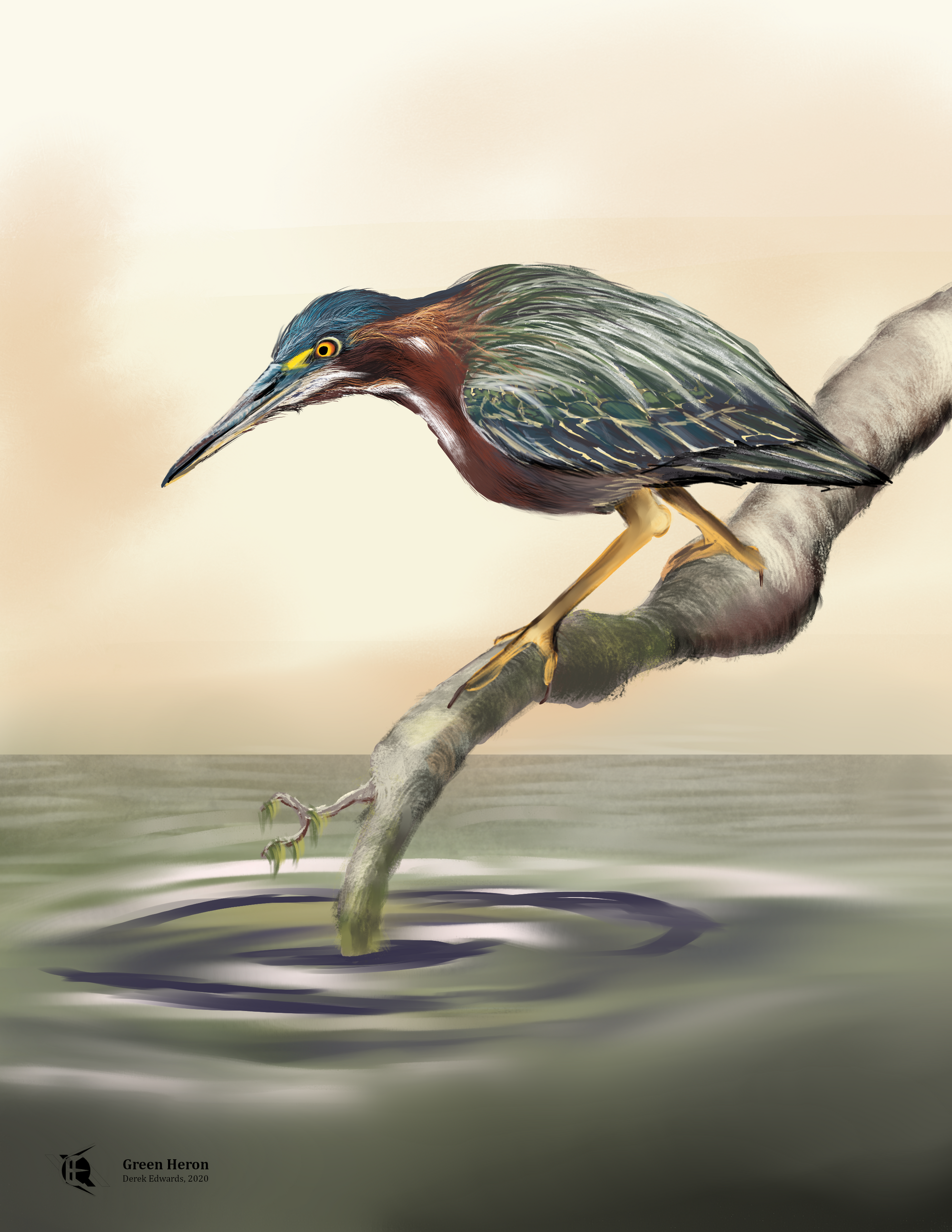
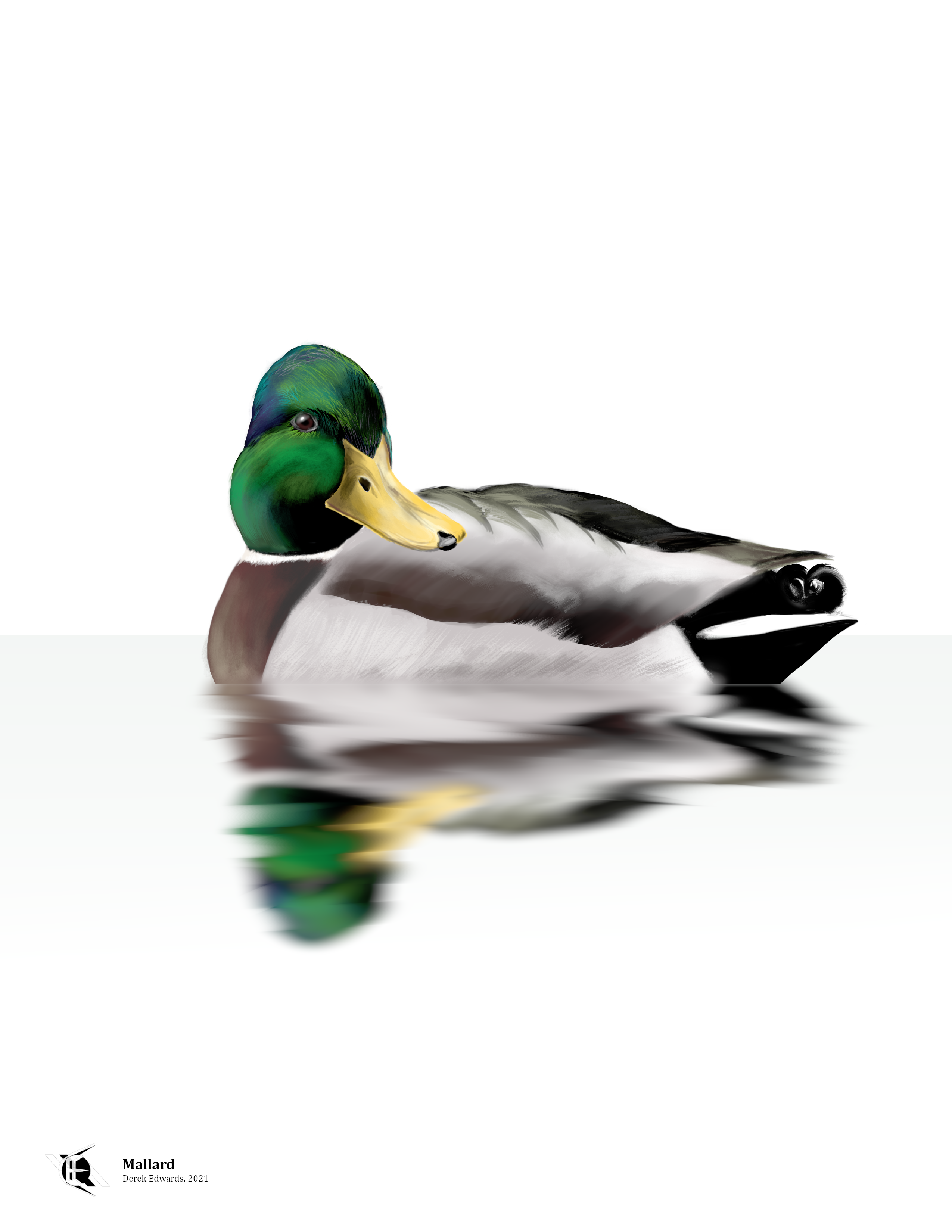
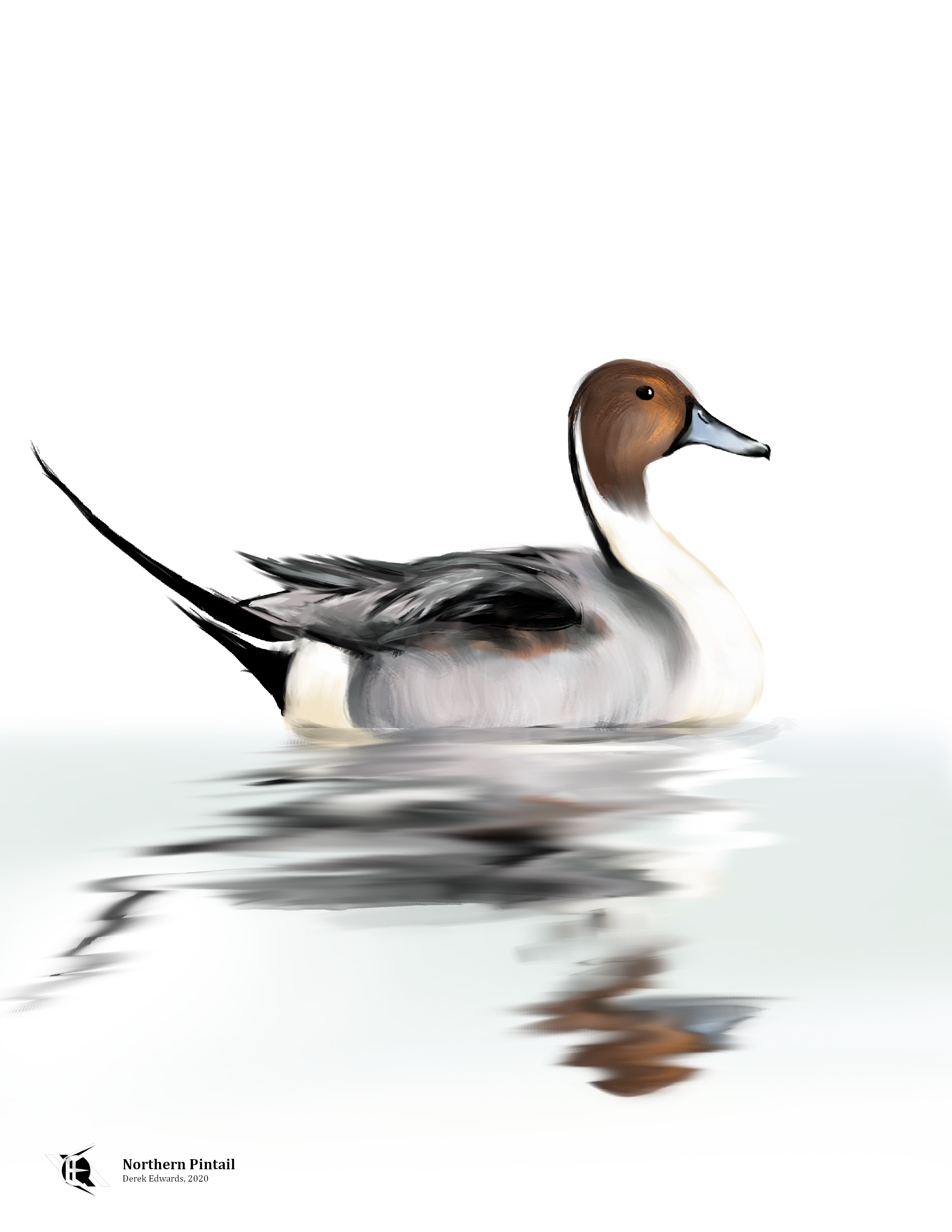
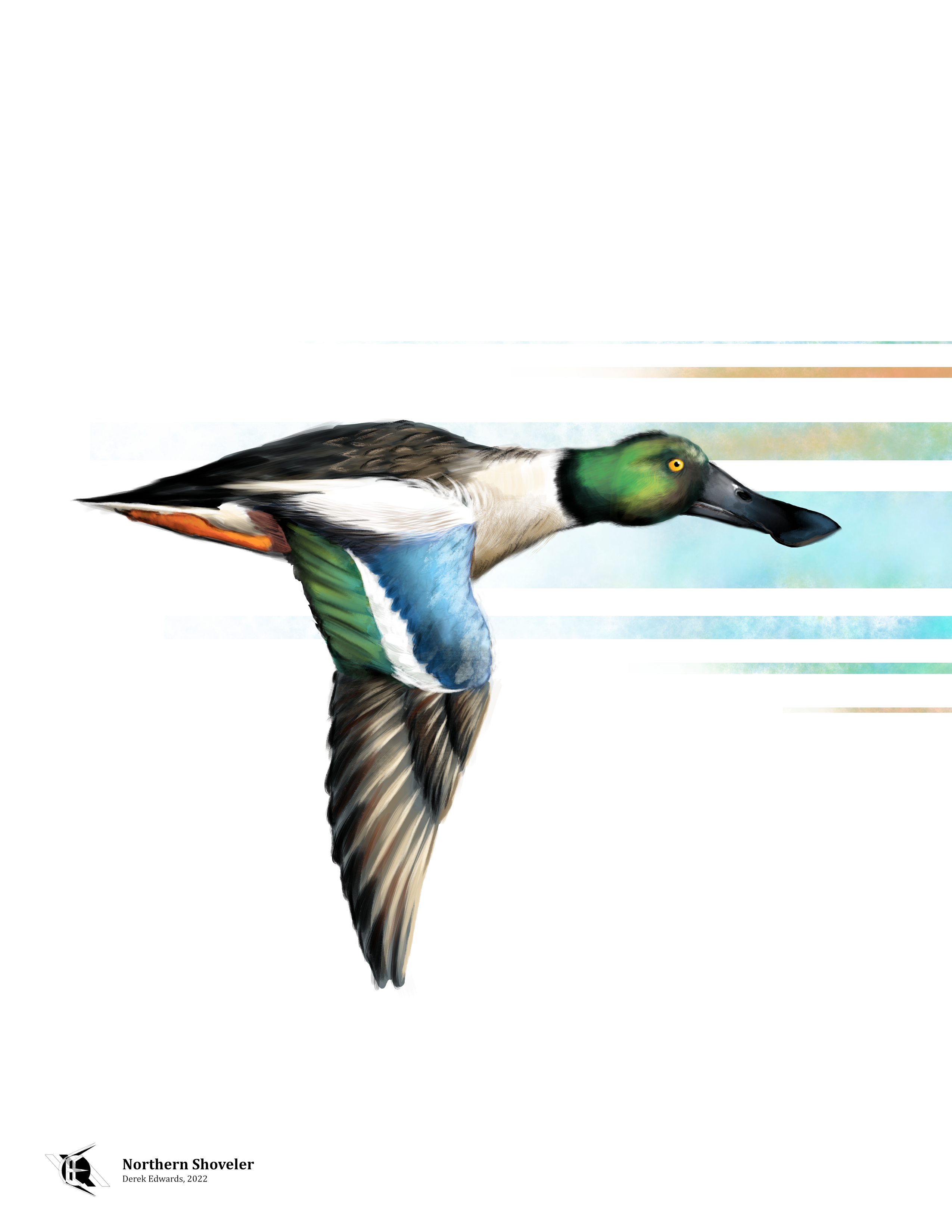
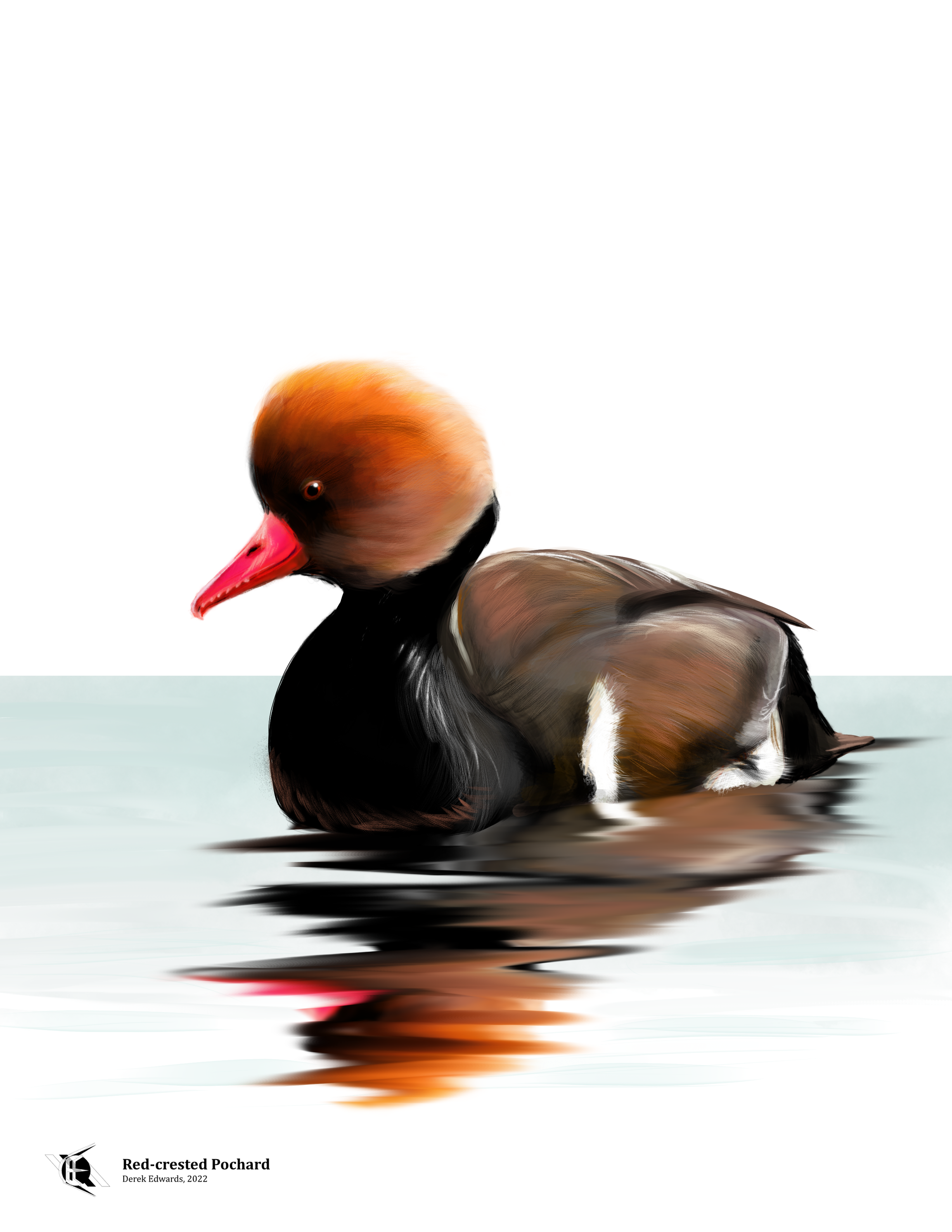
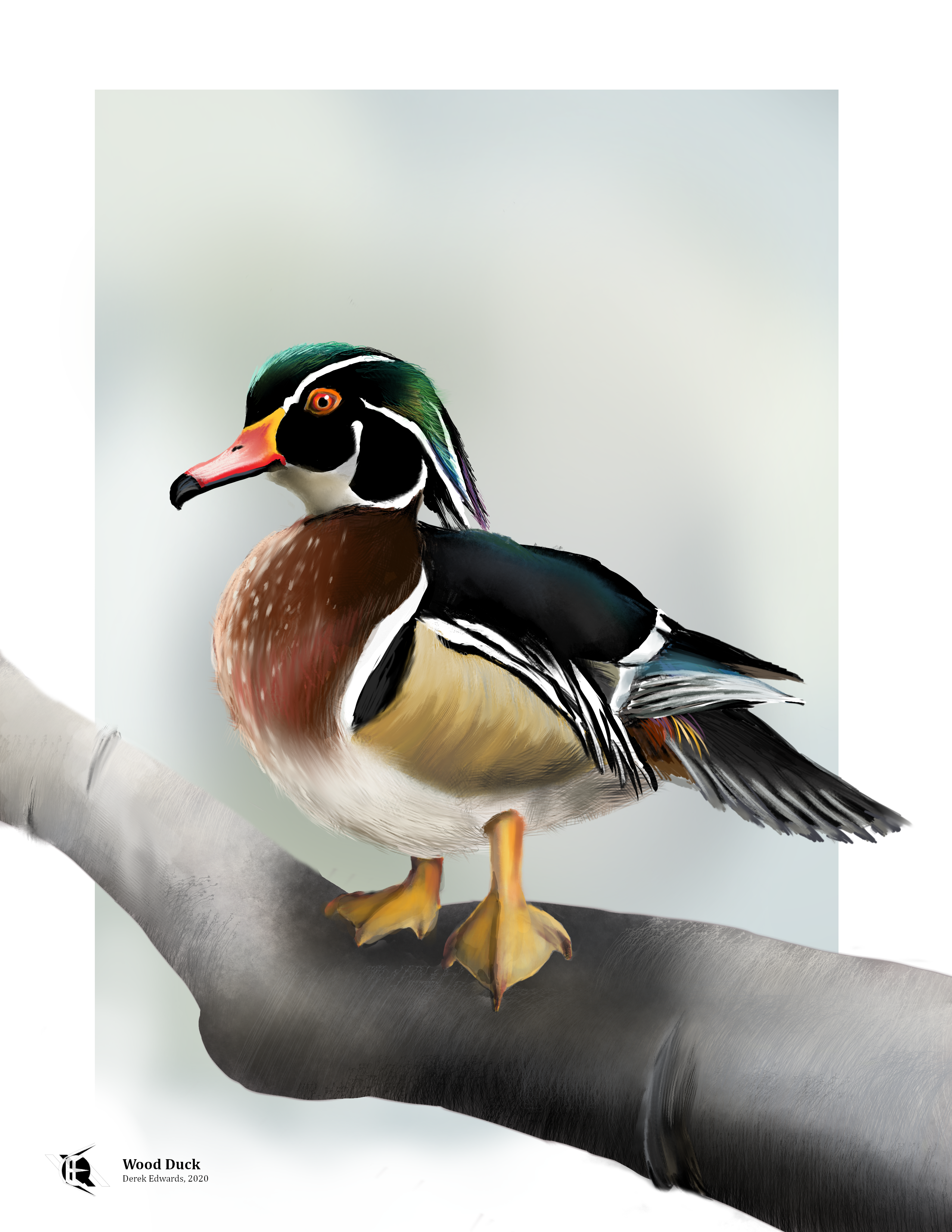
Several kinds of water bird | Artwork by Derek Edwards
Not everyone likes birds. I have many acquaintances who either don't care about birds or actively dislike them. Birds, to them, are the geese that foul their yards, the gulls that raid their picnic at the beach, and the crows that dive at them as they take out the garbage. Even I, a person who likes birds, might say to them, "It's a good thing that you're so pretty." Grackles, a New World doppelganger of starlings, have been observed killing smaller birds at feeders. Many kinds of birds will parasitize nests, laying their eggs to be tended to by another bird. And mallards... actually, you can just look up what mallards have been known to do yourself. Imposing human morals on wild creatures is probably unwise, but birds, in particular, aren't always the most lovably behaving things.
Leaving aside offending our sensibilities, birds can cause us some tangible problems. Rock doves, a species of pigeon found thriving in most cities, pose health and structural hazards through their droppings. And a rural life won't save you from problem birds; lots of birds like to eat grain, and enough of them can put a real dent (haha) in a farmer's harvest. There have been several major programs to save crops from birds. One of the more infamous was the Great Emu War, a series of Australian military actions to protect western wheat farms from large ostrich-type birds, which the emus are often said to have won. More successful was a part of Mao Zedong's "Four Pests Campaign", a program enacted with all the perception and foresight of the lawsuit from Bee Movie, in which "public animals of capitalism", that is, sparrows, were exterminated in much of China, to prevent them from eating the rice crop. I say "more successful" because sparrow populations actually took a serious hit. It was unsuccessful in saving the rice because the sparrows were the only thing keeping the locust population in check.
Mao v sparrows shows that while birds might not always be a benefit, it's best to work with them, rather than against them, since they are a part of the nature of a place. Usually. Sometimes they aren't. Common starlings, for instance, are, in much of their range. an introduced species : a species which piggybacked off humans into a new area. Starlings are native to Europe, but they now inhabit North America and some of Australia. They're much hardier than many of the birds native to those continents, and so they are able to outcompete many birds for food and nesting sites. Such introduced species that dominate their new habitats are often called by a harsher name: invasive. Starlings in the U.S. have been exempted from nature protections, and chemical "starlicides" are sold to poison them, and yet their numbers continue to outpace native birds such as bluebirds and purple martins. That's one way to really get even the bird lovers to hate you: be a pest bird who is a pest even to other birds.

It is early in the morning, and I am back at the pond behind the field. It's a wheat field this year, breaking with the established pattern. The grebe didn't return to this pond this year. Perhaps it was scared off by the new residents, a family of mute swans. Native to Europe and brought to America to live in fancy garden ponds, mute swans are the type most people think of when they think of swans: bright white, curved-necked, and graceful. They're also enormous and mean, and considered invasive in the U.S. Michigan has the most of them of any state, and our Department of Natural Resources will issue permits to drive them off property and destroy their nests, if they become a problem. I'm not sure if these ones are; yes, the grebe is gone, but they don't necessarily return to the same spot every summer. The other birds, the wood ducks, the hooded mergansers, the geese, the blackbirds, the waxwings, the osprey, the kingfishers, the herons, they're all still here. The water-weeds, which form the bottom of the pond's food chain as well as the bulk of the swans' diet, remain plentiful. From my layman's perspective, the mute swans seem to be fitting in as well as native trumpeter swans might. Photos of these swans are all over eBird; if the DNR takes wants to do something, they know where to find them. As for me, I'm not an ornithologist. I'm just a birder.
A large tree has fallen, some years ago, by the look of it, into the pond, it's stump still standing by the path through the woods. Its trunk provides a clear path down to the waters edge, as well as a seat there. I sit on the dry end of the log, and watch the swans as the fly low over the water.
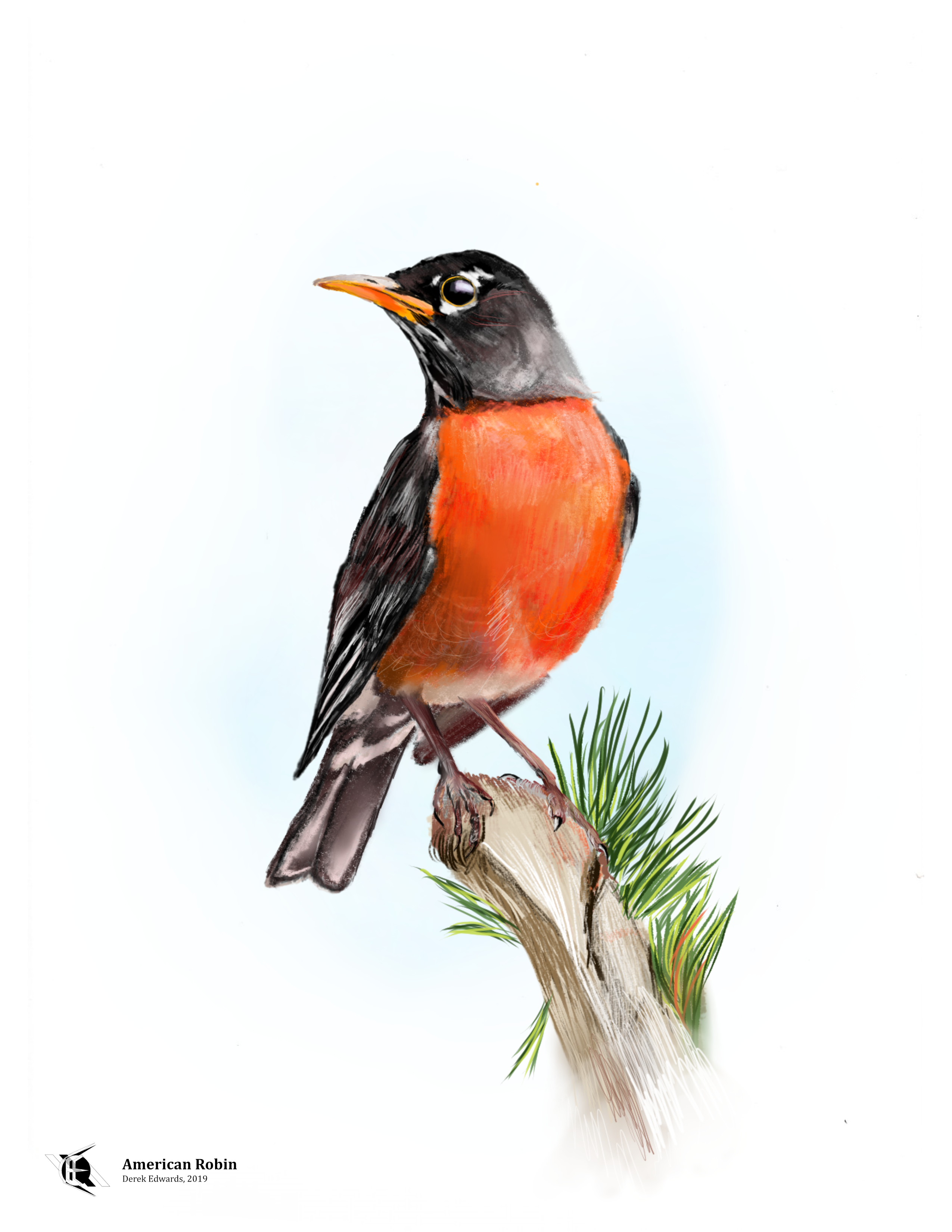
Birds Mentioned
This piece was originally published by Ordinary Times, "a group endeavor to explore and illuminate culture".

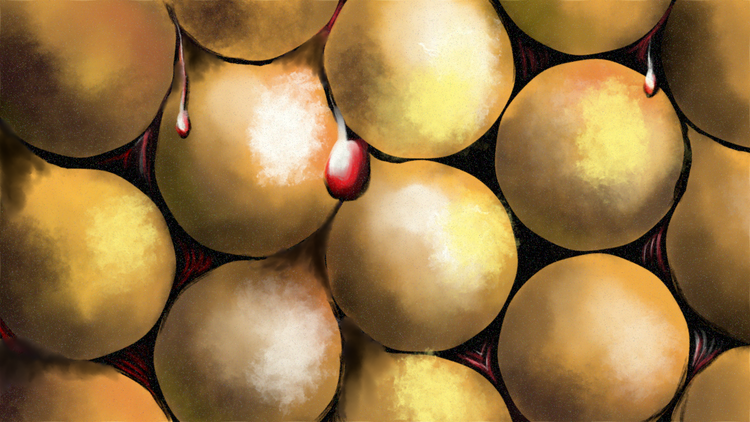
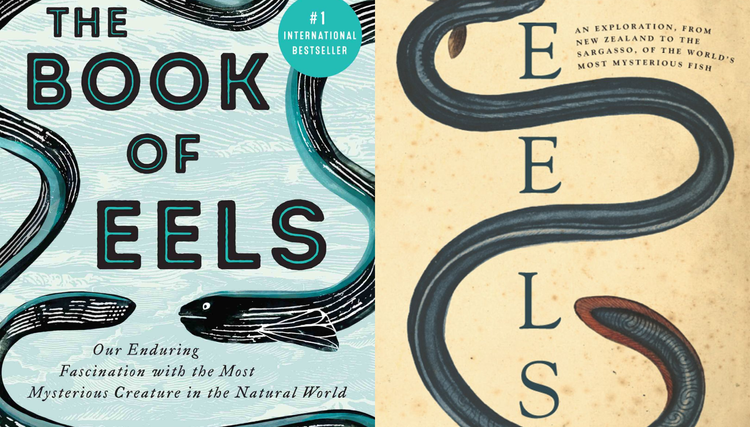

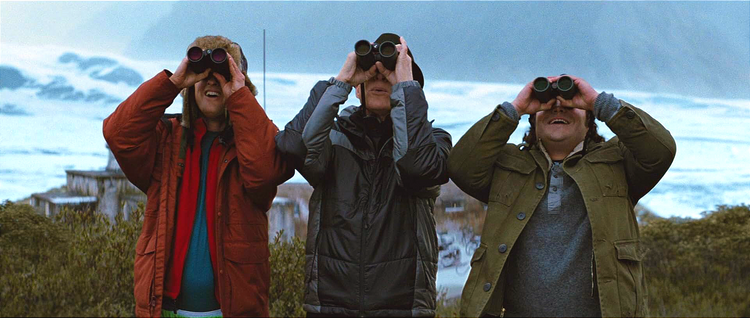
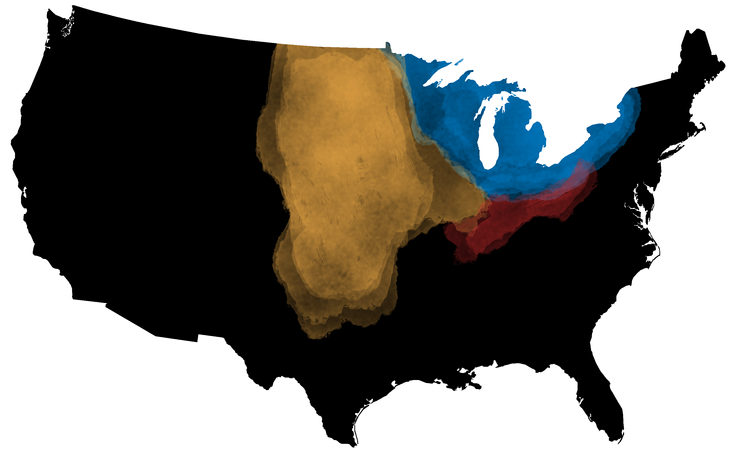
Member Commentary